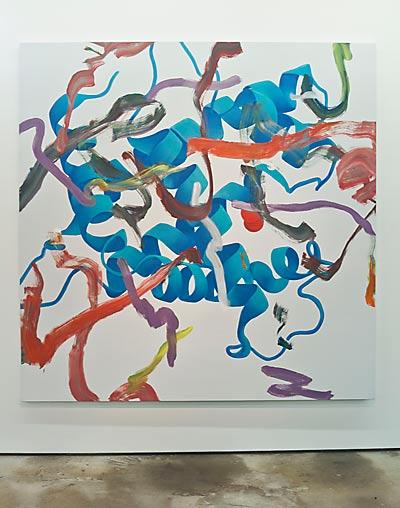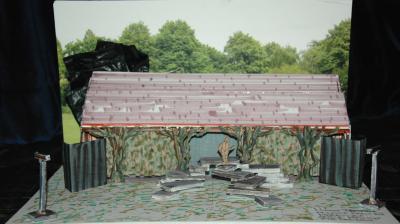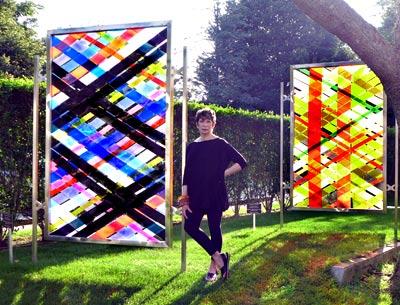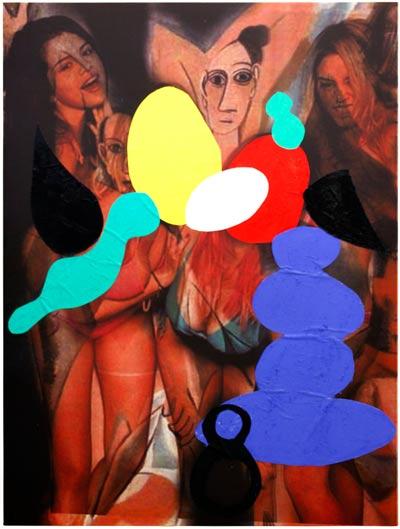Circuits and Sparks at Fireplace
Circuits and Sparks at Fireplace

If a viewer did not know that Alisa Baremboym and Gregory Edwards were newlyweds, it would soon become obvious in seeing their show at the Fireplace Project in Springs. “Contact” is a dialogue between two artists whose lives and vision have become entwined, not literally but with enough feeling to create circuits and sparks throughout the gallery space.
Ms. Baremboym was born in Russia and studied art in London and at the School of Visual Arts and Bard in New York. Mr. Edwards was born and raised on Long Island and studied at the S.V.A. and in Germany. Both artists, who are in their 30s and live in New York City, show regularly, but usually separately.
Here, it is much the same way. There is one piece, “Contact,” which is a joint installation of his painted letters on a long sheet of clear vinyl and her repurposed objects. The letters are a holdover from a recent series of Mr. Edwards’s paintings that included words and punctuation marks. Her stacked paper lanterns are large and one is malformed.
The base lantern appears as if someone sat in it, like a beanbag chair, and the insides have some kind of circuitry that activates a strobe light and creates a buzzing clicking sound, the noise old outdoor lights used to make or what a bug zapper sounds like now. A long strip of black mesh webbing, similar to the material used for a dog training leash, stretches out from the stacked lanterns to where the vinyl banner of letters that spell “C-O-N-T-A-C-T” spills down from the ceiling to the floor. The connections here are both implied and quite literal.
The alcove the piece is placed in is separated by long yellow window-tint strips that cast a sickly glow on the objects, or what Mr. Edwards might call “rancid yellow” if a previous interview is any indication. From very few elements, the artists have realized a transformative environment from the joining of their unique visions. The piece also implies that the coming together of two bodies to create contact may not always be the happily-ever-after fairy tale romantic kind. The dented lantern and the bilious yellow cast of the room hint at damage and sickness. Mr. Edwards’s flaccid banner casts other allusions.
Sometimes our world offers too much contact, and the electric noise of the piece hints at the constant buzzing of text and email alerts, a kind of pseudo-contact that is ever-present, but in many ways unsatisfying. Both artists have said they appreciate the ambiguities and multifaceted aspects of people and objects and it shows here.
Back into the reassuring glow of the gallery’s florescent bulbs, the artists return to more business as usual. Mr. Edwards displays a group of “Protein Paintings,” works in oil and acrylic on canvas that begin with the rendering of the structure of protein molecules and end with the artist’s more gestural brushstrokes in signature colors like his “plastic gray” and “poisonous orange.” The multivalence of the real object depicted looking abstract plus the gestural mark-making yield paintings that are not only visually engaging but intellectually stimulating as well.
Ms. Baremboym’s mysterious objects bring together disparate hard and soft materials to form objects that serve no purpose, but instead imply a certain utility, as if they were just waiting for someone to invent their function. Since she often embellishes them with pretty and delicate elements, typically pigment prints on silk gauze, it appears she wants to remind the viewer to abandon that assumption in favor of the sculpture’s value as an aesthetic object. Since they are not fully either thing, one could get lost in the tension between these two modes of interpretation for hours. What remains after one walks away is that exquisite frailty, the remnants of a soul still reaching out for tactile connection in a virtual world.
The exhibition is on view until Monday.



